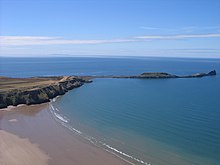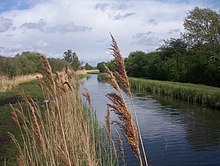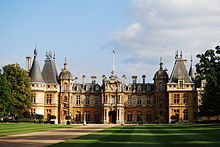National Trust


The National Trust for Places of Historic Interest or Natural Beauty (German as: "National trusteeship for places of historic interest or natural beauty"), usually shortened to National Trust, is a non-profit organization , the objects in the field of historic preservation and conservation in England , Wales and Northern Ireland . Scotland has its own organization for the same purpose, the National Trust for Scotland . With 4.1 million members, the National Trust is Europe's largest organization for the protection of culture and nature and one of the largest organizations in Great Britain. President is Prince Charles . The administrative headquarters are in Swindon in South West England .
history
The National Trust was founded in 1895 during the Victorian Age . Its founders included Octavia Hill , Sir Robert Hunter, and Canon Hardwick Rawnsley. The aim was to preserve buildings or landscapes of historical interest or particular beauty. The basic idea was that only private ownership of buildings and land can protect them from later destruction or construction by the state or companies.
The association's statutes stipulate that property or buildings once acquired may not be resold by the trust.
Buildings, gardens and other things
The trust currently owns around 200 historic buildings and gardens, as well as 47 industrial buildings and mills, 49 churches and chapels, a few pubs and 19 castles.
After the Second World War, instead of high inheritance taxes, many British nobles gave their mansions to the state, which then gave them to the National Trust. The first house the National Trust acquired in this way was Cotehele House owned by the Edgcumbe family in 1947 . Numerous other homes the National Trust took over in lieu of inheritance taxes include Penryhn Castle (1952), Castle Ward (1953), Petworth House (1954), Ickworth House (1956) and Saltram House (1957). Often, however, the owners were able to agree on a right of residence that was granted to them in part of the premises.
The largest donation to the National Trust is considered to be Kingston Lacy's donation . After his death in 1981, the last resident, Ralph Bankes , gave the National Trust not only the mansion and its magnificent art treasures, but also its 64 km² property.
Today the National Trust owns 1.5 percent of the land, including a quarter of the Lake District , and 1,193 kilometers of coastline, with approximately 2,550 square kilometers of real estate . This is about ten percent of the entire coast. The most visited attraction is Giant's Causeway with over 500,000 visitors in 2014. Chartwell , 20 Forthlin Road and 251 Menlove Avenue are also accessible through the National Trust as the homes of famous British people such as Winston Churchill , John Lennon and Paul McCartney .
Unless this is prevented by construction work, the trust opens its property for visitors for an entrance fee. The numerous monuments and parks are open to members of the organization free of charge. For a longer tour through England, Wales and Scotland, it can therefore be useful to join the National Trust beforehand; there are also tourist passes for seven days. In 2004, around 50 million people visited the facilities of the National Trust, through which four out of five historic houses are open to the public.
Finances
The budget of the National Trust is around 470 million euros. This venture is financed primarily through membership fees, unpaid work by the 61,000 volunteers, donations, inheritances and gifts. The income from the souvenir shops, restaurants and rentals also flow into the budget. In the United States, The Royal Oak Foundation was established to make fundraising easier.
Other collections
The National Trust also collects extraordinary things. He can 26 samurai weapons equipment , the Oscar of George Bernard Shaw , a national collection of lawn mowers , 57 meat tenderizer and a photo album called the size of a postal stamp his own.
The most famous monument that is mistakenly assigned to the National Trust is Stonehenge . Although the National Trust owns 850 hectares of land on which this prehistoric structure stands, and through an agreement, National Trust members have free entry to the complex, the actual structure is managed and looked after by English Heritage .
Worldwide impetus
There are similar organizations in Australia, for example . In Germany, Gottfried Kiesow founded the German Foundation for Monument Protection in 1985, based on the English model . In 1986, the state of North Rhine-Westphalia founded the North Rhine-Westphalia Foundation for Nature Conservation, Homeland and Cultural Preservation ( NRW Foundation ), the non-profit associations, associations and voluntary groups that work in NRW for nature conservation and the preservation of local history and culture use, supported.
In France , the Conservatoire du littoral was founded in 1975 to preserve stretches of coastline. The non-profit Austrian building culture private foundation has existed in Austria since 2000 .
Outstanding and most visited objects

literature
- John Bailey: The National Trust. In: The Town Planning Review (TPR). Vol. 11, No. 3, 1925, ISSN 0041-0020 , pp. 150–156 ( digitized from JSTOR (subject to a charge) ).
- MV Beaumont: The National Trust of England. In: IBI Bulletin. No. 37, 1980, ISSN 1011-1107 , pp. 75-78.
- Martin Drury: The National Trust and its Role in the Conservation of Buildings, Gardens and Landscape in Britain . In: The garden art . Vol. 9, No. 1, 1997, ISSN 0935-0519 , pp. 74-84.
Web links
Individual evidence
- ↑ Travel report on zeit.de , accessed on November 28, 2011
- ↑ Who we are. National Trust, accessed June 9, 2013 .
- ^ Treasure Hunt: National Trust Collections. Retrieved March 12, 2013 .
- ↑ Kingston Lacy. Retrieved December 16, 2015 .
- ↑ Information on the official website of the National Trust ( Memento of the original from November 27, 2011 in the Internet Archive ) Info: The archive link was inserted automatically and has not yet been checked. Please check the original and archive link according to the instructions and then remove this notice. , accessed November 29, 2011
- ↑ National Trust Annual Report 2013/2014: Visiting Features. (No longer available online.) Archived from the original on April 2, 2015 ; accessed on March 18, 2015 . Info: The archive link was inserted automatically and has not yet been checked. Please check the original and archive link according to the instructions and then remove this notice.
- ↑ Information on the official website of the National Trust , accessed November 29, 2011
- ↑ National Trust Annual report 2014/15. (PDF) National Trust, accessed December 16, 2015 .
- ↑ Interview with the founder Kiesow on the official website of the German Foundation for Monument Protection ( Memento from September 21, 2011 in the Internet Archive ), accessed on November 28, 2011
- ↑ NRW Foundation - Internet presence. In: www.nrw-stiftung.de. Retrieved April 1, 2016 .
- ↑ National Trust: Top 10 Castles. Retrieved March 18, 2015 .
- ↑ National Trust Annual Report 2013/2014: Visiting Features. (No longer available online.) Archived from the original on April 2, 2015 ; accessed on March 18, 2015 . Info: The archive link was inserted automatically and has not yet been checked. Please check the original and archive link according to the instructions and then remove this notice.
- ↑ Visit Britain: Top 10 National Trust Visiting Tips. Retrieved March 18, 2015 .

